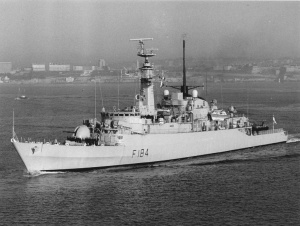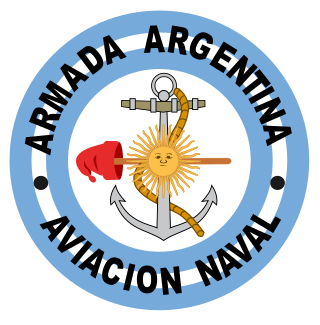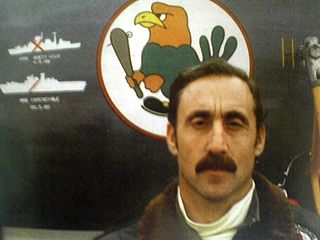
The Falklands War was a ten-week undeclared war between Argentina and the United Kingdom in 1982 over two British dependent territories in the South Atlantic: the Falkland Islands and its territorial dependency, South Georgia and the South Sandwich Islands. The conflict began on 2 April 1982, when Argentina invaded and occupied the Falkland Islands, followed by the invasion of South Georgia the next day. On 5 April, the British government dispatched a naval task force to engage the Argentine Navy and Air Force before making an amphibious assault on the islands. The conflict lasted 74 days and ended with an Argentine surrender on 14 June, returning the islands to British control. In total, 649 Argentine military personnel, 255 British military personnel, and three Falkland Islanders were killed during the hostilities.

HMS Invincible was the Royal Navy's lead ship of her class of three light aircraft carriers. She was launched on 3 May 1977 as the seventh ship to carry the name. She was originally designated as an anti-submarine warfare carrier, but was used as an aircraft carrier during the Falklands War, when she was deployed with HMS Hermes. She took over as flagship of the British fleet when Hermes was sold to India. Invincible was also deployed in the Yugoslav Wars and the Iraq War. During the Falklands Conflict, Argentinian media reported Invincible as sunk on several occasions. In 2005, she was decommissioned, and was eventually sold for scrap in February 2011.
This is a list of the naval forces from the United Kingdom that took part in the Falklands War, often referred to as "the Task Force" in the context of the war. For a list of naval forces from Argentina, see Argentine naval forces in the Falklands War.

The Exocet is a French-built anti-ship missile whose various versions can be launched from surface vessels, submarines, helicopters and fixed-wing aircraft.

This article describes the composition and actions of the Argentine air forces in the Falklands War, which comprised units of the Air Force, Army, Navy and other services.

The Douglas A-4 Skyhawk is a single-seat subsonic carrier-capable light attack aircraft designed and produced by the American aerospace manufacturer Douglas Aircraft Company, and later, McDonnell Douglas. It was originally designated A4D under the United States Navy's pre-1962 designation system.

HMS Ardent was a Royal Navy Type 21 frigate. Built by Yarrow Shipbuilders Ltd, Glasgow, Scotland. She was completed with Exocet launchers in 'B' position. Ardent took part in the Falklands War, where she was sunk by Argentine aircraft in the Falkland Sound on 21 May 1982.

The Argentine Navy is the navy of Argentina. It is one of the three branches of the Armed Forces of the Argentine Republic, together with the Army and the Air Force.

The Dassault-Breguet Super Étendard is a French carrier-borne strike fighter aircraft designed by Dassault-Breguet for service with the French Navy.

Atlantic Conveyor was a British merchant navy ship, registered in Liverpool, that was requisitioned during the Falklands War.
ARA Santísima Trinidad is a Type 42 destroyer of the Argentine Navy, the only one of her class built outside Britain. She participated in the 1982 Falklands War. In January 2013 the ship capsized and sank at her moorings in the Argentine naval base of Puerto Belgrano due to lack of maintenance, being refloated in December 2015. The navy's plan to turn her into a museum ship was not realised and, in 2020, the Argentine president stated that the ship should be scrapped, though this was later blocked by federal courts.
This article describes the composition and actions of the Argentine naval forces in the Falklands War. For a list of naval forces from the United Kingdom, see British naval forces in the Falklands War.

ARA Veinticinco de Mayo (V-2) was an aircraft carrier in the Argentine Navy from 1969 to 1997. The English translation of the name is Twenty-fifth of May, which is the date of Argentina's May Revolution in 1810.
These are some of the key weapons of the Falklands War used by both sides.

Operation Mikado was the code name of a military plan by the United Kingdom to use Special Air Service troops to attack the home base of Argentina's five Super Etendard strike fighters at Río Grande, Tierra del Fuego, during the 1982 Falklands War. Brigadier Peter de la Billière was in charge of planning the operation.

The Argentine Naval Aviation is the naval aviation branch of the Argentine Navy and one of its four operational commands. Argentina, along with Brazil is one of two South American countries to have operated two aircraft carriers.
The Battle of San Carlos was a battle between aircraft and ships that lasted from 21 to 25 May 1982 during the British landings on the shores of San Carlos Water in the 1982 Falklands War. Low-flying land-based Argentine jet aircraft made repeated attacks on ships of the British Task Force.

Gringo–Gaucho are a contingent set of maneuvers performed between the Argentine Naval Aviation and United States Navy's aircraft carriers. The US Navy refers to them as Southern Seas in their last edition. Gringo and Gaucho are linguistic and folkloric designations of long standing, respectively.

Captain Roberto Curilovic is a former Argentinian Navy pilot. On 25 May 1982 in the Falklands War, he sank the transport ship Atlantic Conveyor with an Exocet AM.39 anti-ship missile.

Frigate Captain Augusto Bedacarratz is an Argentina naval aviator who led the mission on 4 May 1982 that sank HMS Sheffield during the Falklands War using the Exocet AM.39 anti-ship missile. It was the first sinking of a Royal Navy ship in four decades.
















